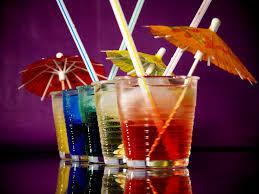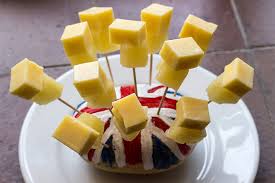"the time when pickles on toothpicks were still the height of sophistication." Renee Zellweger
That quote is sort of appropriate for the inspiration for this post - an episode of The Durrells, in which there was a party, with lots of food on toothpicks. David remarked that back in the 1930s when this was set, they surely didn't have toothpicks. I think he was remembering our youth in the 1950s and 1960s, when we did indeed stick things on toothpicks. As above. Mostly cheese and those luridly coloured cocktail pickled onions, or perhaps a bit of ham - even fish.
I actually spent some time today, looking for a photograph that I remember from my time at university. There I am with my friend Mary in the kitchen of our residence's common room preparing food for a party. I think it might have been my 21st. I couldn't find the photograph, so I don't know whether it actually showed any of the food, but I do remember that for all of my and my friends' parties there, a lot of the food options would be things skewered on to toothpicks - or cocktail sticks - which were generally a little sturdier. I even remember - oh the horror - tinned pilchards somehow. I'm pretty sure I would not have done anything as sophisticated as making a pâté with them.
We still use toothpicks, cocktail sticks and bamboo skewers of varying degrees of decorative artistry at today's parties, but these days the sticks are more often or not just there for you to use if you want to. Or else they are used in a rather more aesthetic way. At least that's what we think now. Back in the 50s and 60s, we thought we were very trendy. No doubt the people of the 2090s will look back in horror at what we thought was absolutely the height of sophistication today, although do let's hope that they will still be able to eat such things - some examples below, with an example of the myriad of crafty options for how to make your own little sticks:
But back to The Durrells. David was actually out by millions of years. I turns out that hominids everywhere have been using some kind of toothpick for 1.8 million years. In Georgia - the Russian one, not the American one - at a place called Dmanisi a skull has been found, whose teeth bear marks of having been scraped between. Ditto the Neanderthals, who were also extensively into scraping something against their teeth. Well it's very irritating to have something stuck between your feeth isn't it? They also think that as well as removing things from between - the earliest form of cleaning your teeth - these toothpicks were also used to relieve pain. They don't know what they were made of - indeed they probably weren't actually made - more likely a suitable sized piece of wood, or grass, or leaf. The evidence is from the marks on the teeth.
By the time we are into urban civilisations the toothpicks were being fashioned out of rather more sturdy stuff - bone, metal, etc. And it happened absolutely everywhere in the world. These implements, of course, became status symbols and were made from precious metals, carved and jewelled and kept in equally elaborate little boxes. Often the implement was partly a toothpick and partly an earwax spoon, which sounds repulsive, but some of them are things of beauty. One assumes the peasants just had to continue scraping away with a twig or a blade of grass, if they did anything at all.
By the 16th century some nuns in Portugal had worked out a way of manufacturing them in larger quantities to help them eat the sweet and sticky things that they made in their nunneries. And the Portuguese outside the convents started to make them too and exported them to their colonies. But it wasn't until the early nineteenth century that an American called Charles Forster saw them in Brazil and thought it such a good idea that he determined to work out how to manufacture them en-masse. First persuade your prospective audience to buy them apparently. The Americans, at first, could see no point in buying such a simple thing.
The plain wooden toothpick, it may be argued, is among the simplest of manufactured things. It consists of a single part, made of a single material, intended for a single purpose-from which it gets its simple name. It is also among the most convenient and ready of things. It can be used directly out of the box-there being no instructions to read, no parts to assemble, no priming or booting required, and no maintenance expected. When it has served its purpose, it is simply discarded. Henry Petroski
However, he was eventually successful. These days you can buy them in any length, plain, or decorated in thousands of different ways. Ironically some dentists these days, don't recommend them for tooth care because they say you can damage your gums. Others recommend you use them, or rather their modern day equivalents - interdens toothbrushes, dental floss, those little brushes in varying widths - some to the exclusion of actually brushing your teeth. Personally I think that since I have been using those tiny brush/toothpick things, and an electric toothbrush, my teeth and gums have improved enormously. But I do use the occasional actual toothpick for removing an irritating bit of meat or vegetable stuck in my teeth after dinner.

And what about the toothpick's close relative the cocktail stick? Well I guess the cocktail stick goes back to the invention of cocktails. Now I am not a cocktail drinker - although I have at times enjoyed the odd one. This one here is called a Sazerac and some have claimed it as the very first cocktail - from New Orleans at the very beginning of the 19th century. Those early cocktails were simply a mixture of spirits, sugar, water and bitters. Today it's rather an art form.
It's an interesting name though isn't it? There are competing theories for where it comes from but I rather like this one:
"It was customary to dock the tails of horses that were not thoroughbred [...] They were called cocktailed horses, later simply cocktails. By extension, the word cocktail was applied to a vulgar, ill-bred person raised above his station, assuming the position of a gentleman but deficient in gentlemanly breeding. [...] Of importance [in the 1806 citation above] is [...] the mention of water as an ingredient. [...] Låftman concluded that cocktail was an acceptable alcoholic drink, but diluted, not a "purebred", a thing "raised above its station". Hence the highly appropriate slang word used earlier about inferior horses and sham gentlemen." Anatoly Liberman (1946) - Wikipedia
But what about those cocktail sticks? Their use is threefold it seems to me.

First - to pierce that olive that goes in the Martini - and a whole lot of other things that bartenders have dreamt up since.
Then there's the umbrellas and all the other things that you can stick in a cocktail for decoration. Where did the umbrella come from? Well they think from the 1950s in America when Tiki culture was all the rage. Tiki being loosely defined as Pacific Island things.
"A bartender named Harry Yee at the Hilton Waikiki was the first. He used to garnish his cocktails with a stick of sugarcane, but that was at the time that everybody was still smoking cigarettes. After they chewed on the sugarcane, they'd set it in the ashtrays, and he would have to scrub them clean. So he came up with something new." Rochelle Bilow - Bon Appétit

It has also been suggested that the umbrellas were used because they cooled the drinks from the hot sun in those places, but the scientists think this is all a bit rubbish. You would have drunk your cocktail before the sun had warmed it up. Another theory is the umbrellas - produced in China - were around - in quantity - and one of those bartenders just thought it would be a fun thing - and alas a bit sexist.
"Some speculate that the cocktail umbrella was a marketing ploy to lure women to the bars—after all, what lady can resist a darling paper parasol in her mai tai?" Rochelle Bilow - Bon Appétit
Alas she's sort of right. I think women are fundamentally more into bright colours and bling and dare I say fun? - not exclusively of course, but mostly. These days you can have all manner of stuff decorating your cocktail. I remember my mother drinking Pimms in pubs - and they always had so much stuff in them that she could hardly get at the drink.

Lastly there is the cocktail stirrer which admittedly tends to be something rather more substantive than a cocktail stick. Why do you stir a cocktail anyway?
"When you make a stirred drink, you minimize the amount of dilution that occurs, allowing for less ice water to mix in with your ingredients and better balance the concentration of spirits. Cocktails that should be stirred are ones that are composed fully of spirits, tonics, bitters, or drinks that are built in the cocktail glass they’ll be served in." Masterclass
However, the toothpick is one of those very simple things that can be used for all manner of other stuff. You will find lots of sites with lists of useful things you can do with toothpicks - cleaning those tight gaps between the letters on your computer keyboard for example. And art. Yes you can make amazing structures with them - some just for fun, some real art - the last one, not yet completed is a memorial to the holocaust:

A toothpick – the go-to little tool you select after a meal of corn on the cob, an object you absentmindedly chew on while listening to an unremarkable conversation, the piece of wood you carelessly toss away … this everyday item actually has a rather interesting history behind it." Ancient Origins































Comments